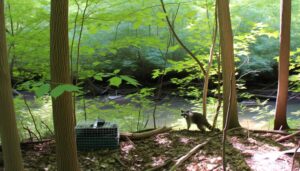How Do Raccoons Leave Your Attic During the Day?
Raccoons, primarily nocturnal creatures, occasionally leave attics during the day. This behavior can be driven by factors such as food scarcity, environmental disruptions, or the need to care for their young.
Indicators of their daytime presence include audible signs like scratching and movement noises. Raccoons might exploit urban food sources or engage in nest-building activities during daylight.
Their presence in attics poses health risks and can cause structural damage. Understanding the reasons behind their daytime activities and the impact on home environments can aid in effective prevention and safe removal methods, ensuring a raccoon-free space.
Discover the strategies to manage these intrusions efficiently.

Key Takeaways
- Raccoons occasionally leave attics during the day for activities like foraging and nest-building.
- Environmental stressors and food scarcity can cause raccoons to be active during daylight hours.
- Audible disturbances like scratching and thumping indicate raccoon presence during the day.
- Daytime excursions may occur due to the need to care for young or find food.
- Preventing raccoon presence involves habitat modification and regular monitoring.
Raccoon Nocturnal Behavior

Raccoons, mostly nocturnal creatures, exhibit behaviors that are finely tuned to nighttime activities. Utilizing their keen sense of smell and tactile abilities, raccoons navigate their environment with remarkable efficiency in the dark.
Their nocturnal foraging habits are driven by an omnivorous diet, ranging from fruits and nuts to small mammals and insects. This behavior not only allows them to avoid daytime predators but also to exploit food resources with minimal competition.
Additionally, their distinctive dexterity enables them to manipulate objects and access food in complex environments. Observational data indicate that raccoons are highly adaptable, capable of altering their nocturnal patterns in response to environmental changes, such as urbanization.
This adaptability underscores their success as a resilient species.
Common Daytime Activities
Observations indicate that raccoons occasionally leave their attic shelters during daylight hours to engage in critical survival activities. Primarily, these activities involve foraging for food to sustain their energy needs and engaging in nest-building behaviors to enhance their living conditions.
Such behaviors can be influenced by various factors including food availability and the need for a secure habitat.
Foraging for Food
During daylight hours, raccoons exhibit foraging behaviors that are strategically adapted to their environments and dietary needs. These nocturnal creatures occasionally venture out during the day, particularly when food resources are scarce or if they feel secure from predators.
Their diet is omnivorous, encompassing fruits, nuts, insects, small vertebrates, and human refuse. Observational studies indicate that raccoons utilize their highly sensitive tactile abilities to locate food, often using their front paws to manipulate objects and extract edible items.
Foraging during the day may also be influenced by seasonal variations and reproductive cycles, necessitating increased caloric intake. Importantly, urban raccoons frequently exploit anthropogenic food sources, demonstrating their remarkable adaptability and opportunistic feeding strategies.
Nest Building Activities
In addition to foraging, raccoons engage in nest building activities during the day. They meticulously construct and maintain their dens to guarantee safety and comfort. These activities include gathering materials such as leaves, twigs, and insulation to create a secure and insulated nest.
Observational studies indicate that raccoons exhibit a high level of meticulousness in arranging these materials. They often optimize the structure to protect against predators and environmental elements. Analytical assessment of their behavior reveals an innate ability for spatial organization. This allows them to create complex nests that are both functional and concealed.
Such activities underscore the raccoon's adaptability and resourcefulness. They highlight their capacity for problem-solving and environmental manipulation to enhance their survival prospects.
Signs of Daytime Presence

Raccoons are primarily nocturnal creatures, making their daytime presence an anomaly worth noting.
Observing unusual noises during daylight hours, such as scurrying or scratching, can be indicative of their activity.
Analyzing these deviations from their natural habits provides critical insight into their behavior and potential causes for their altered patterns.
Nocturnal Habits Overview
Despite their primarily nocturnal behavior, raccoons can occasionally exhibit signs of activity during daylight hours, indicating possible disruptions in their usual habits. Such disruptions may be attributed to various factors, including food scarcity, environmental stressors, or the presence of young raccoons requiring additional care.
Observational data suggest that raccoons, though adapted to night-time foraging, possess the flexibility to adjust their activity patterns when necessary. This adaptability is a survival trait, allowing them to exploit resources or avoid threats. Scientifically, such behavior underscores the importance of understanding raccoons' ecological plasticity.
Analyzing these daytime activities provides insight into their behavioral ecology, revealing how external pressures can influence their temporal activity patterns, thereby affecting their interaction with human habitats.
Daytime Noise Indicators
Audible disturbances such as scratching, thumping, or vocalizations emanating from the attic during daylight hours can serve as reliable indicators of raccoon presence. These sounds often result from raccoons engaging in activities such as nesting, grooming, or interacting with offspring.
Observational data suggest that while raccoons are primarily nocturnal, they may exhibit diurnal activity, particularly when undisturbed or during specific life stages such as rearing young. Analyzing the patterns and intensity of these noises can provide insights into the raccoons' behavior and their possible nesting locations within the attic.
Recognizing these auditory cues is essential for timely intervention and effective management of raccoon infestations, thereby mitigating potential structural damage and health risks.
Reasons for Daytime Departure
Driven by various environmental and behavioral factors, raccoons may vacate attics during daylight hours. One primary reason is the search for food, especially during periods of scarcity.
While raccoons are typically nocturnal, they can adapt their foraging habits if nighttime resources are insufficient. Additionally, disturbances within the attic, such as human activity or temperature fluctuations, can prompt daytime movement.
Maternal instincts also play a role, as mother raccoons may leave to find food for their young. Lastly, social dynamics within raccoon populations, including territorial disputes or mating behaviors, can necessitate temporary departures during the day.
Understanding these motivations provides insight into their flexible and opportunistic nature, which is essential for effective management and control strategies.
Impact on Home Environment

The presence of raccoons in the attic can have several detrimental effects on the home environment. Increased noise and disturbances disrupt daily life. Additionally, these animals pose significant health and safety risks. Raccoons can transmit diseases and contaminate living spaces. Structural damage is also a concern. Raccoons can compromise the integrity of insulation, wiring, and other building materials.
Noise and Disturbances
Raccoons inhabiting the attic can generate considerable noise, which may disrupt the tranquility of the home environment. These nocturnal creatures are most active during nighttime, causing disturbances that can interrupt sleep patterns. Sounds such as scratching, thumping, and vocalizations are common, resulting from their movements and interactions. Additionally, raccoons may displace insulation or other materials, amplifying noise levels.
This auditory disruption can lead to increased stress and discomfort for residents. Observational data indicate that raccoon activity peaks during dusk and dawn, coinciding with their natural foraging behaviors. Consequently, homeowners may experience significant disturbances during these periods. Understanding the behavioral patterns of raccoons is essential for devising effective mitigation strategies to restore peace within the living space.
Health and Safety
The infiltration of raccoons into the attic presents significant health and safety risks to the home environment. These animals are known carriers of pathogens like rabies, leptospirosis, and raccoon roundworm, which can pose severe health hazards to humans.
Raccoon feces, urine, and nesting materials can build up, creating unsanitary conditions that promote mold growth and attract other pests. Moreover, their presence may trigger allergic reactions in sensitive individuals.
Regarding safety, raccoons can exhibit aggressive behavior if cornered or threatened, potentially causing harm to residents. The pollution and potential zoonotic transmission highlight the importance of promptly addressing raccoon infestations to protect both health and safety within the home.
Structural Damage
While raccoons in the attic pose significant health risks, their presence can also lead to substantial structural damage to the home environment. These nocturnal creatures are known for their formidable dexterity and strength, which they use to gain entry by tearing shingles, fascia boards, and soffits.
Once inside, they can damage insulation material, electrical wiring, and wooden beams. The accumulation of urine and feces not only creates unsanitary conditions but also compromises the integrity of building materials, leading to potential mold growth and unpleasant odors. Additionally, raccoons may gnaw on structural elements, causing further deterioration.
Addressing these issues promptly is critical to preventing costly repairs and maintaining the structural soundness of the home.
Seasonal Behavior Changes
Seasonal behavior changes in raccoons are often driven by variations in temperature and food availability, influencing their activity patterns and habitat preferences. During warmer months, raccoons exhibit increased nocturnal activity due to the abundance of food resources such as fruits, insects, and small animals. Conversely, colder months prompt a shift towards more diurnal activity as raccoons forage for scarce food supplies and seek warmer shelter, often in human structures like attics.
| Season | Activity Pattern | Habitat Preference |
|---|---|---|
| Spring | Nocturnal | Forests, Urban Areas |
| Summer | Nocturnal | Near Water Sources |
| Fall | Nocturnal | Woodlands, Suburban Areas |
| Winter | Diurnal | Human Structures (Attics) |
This seasonal adaptability is essential for raccoons' survival, ensuring they optimize resource acquisition and thermoregulation.
Risks of Daytime Activity

Daytime activity in raccoons poses several risks, including increased exposure to predators and human interaction. This can lead to higher mortality rates and potential for disease transmission.
Predators such as domestic dogs and larger birds of prey are more active during daylight hours, increasing the likelihood of raccoon encounters. In addition, human-raccoon interactions can result in accidents, intentional harm, or capture.
Daytime activity also heightens the risk of raccoons encountering vehicles, leading to road fatalities. Moreover, increased interaction with humans raises the probability of zoonotic disease transmission, such as rabies and leptospirosis, posing health risks to both raccoons and humans.
Understanding these risks is vital for managing raccoon behavior and ensuring both wildlife and public safety.
Identifying Raccoon Tracks
Raccoon tracks are characterized by their distinct five-toed pattern and claw marks, often found in mud, sand, or snow. These tracks can provide vital evidence for identifying raccoon activity near or within a property. Observing raccoon tracks requires a keen eye for detail and an understanding of their unique characteristics.
Key features include:
- Toe Arrangement: Five elongated toes with noticeable spacing.
- Claw Imprints: Sharp, curved claws that leave clear marks.
- Track Size: Forepaw prints are typically 2–3 inches long, while hind paws measure 3–4 inches.
Accurate identification of these tracks can assist homeowners and wildlife professionals in determining the presence and movement patterns of raccoons, thereby informing appropriate management strategies.
Preventing Attic Infestations

Implementing efficient measures to prevent raccoons from entering attics involves a combination of habitat modification, exclusion techniques, and regular monitoring. Habitat modification reduces attractants such as easily accessible garbage and food sources. Exclusion techniques include sealing entry points with sturdy materials, installing chimney caps, and fitting vent covers. Regular monitoring ensures early detection of potential breaches. The following table illustrates key preventative strategies:
| Strategy | Description | Example Implementations |
|---|---|---|
| Habitat Modification | Reducing attractants in the environment | Secure waste receptacles, eliminate food scraps |
| Exclusion Techniques | Blocking entry points | Seal openings, set up chimney caps |
| Regular Monitoring | Periodic inspections and maintenance | Scheduled attic checks, repair deterioration |
These measures, when combined, form an effective defense against raccoon infestations.
Safe Removal Methods
Effective removal of raccoons from attics necessitates humane and scientifically-backed methods to guarantee both the safety of the animals and the integrity of the home. Successful strategies often involve a combination of exclusion techniques, deterrents, and careful monitoring.
- Exclusion Techniques: Utilize one-way doors and exclusion funnels to allow raccoons to exit but prevent re-entry.
- Deterrents: Implement auditory and olfactory deterrents, such as predator urine or high-frequency sound devices, to encourage raccoons to vacate.
- Monitoring: Regularly inspect the attic for signs of re-entry and verify all access points are sealed.
These methods underscore a non-lethal approach while minimizing potential damage to property. Meticulous application of these techniques can lead to the humane and effective resolution of raccoon infestations.
Professional Help Options

Engaging expert wildlife control services can significantly improve the efficiency and safety of removing raccoons from attics. These specialists utilize scientifically proven methods to humanely trap and relocate raccoons, minimizing harm to both animals and humans.
Professionals conduct thorough inspections to identify entry points, nesting sites, and potential hazards. They use specialized equipment, such as live traps and exclusion devices, guaranteeing thorough removal. Furthermore, these services are skilled at handling biohazards associated with raccoon infestations, including feces and parasites, which can pose significant health risks.
Utilizing professional assistance not only ensures compliance with local wildlife regulations but also reduces the chances of recurrence, offering a systematic and effective solution to raccoon intrusions.
Long-Term Prevention Tips
After addressing immediate raccoon infestations with professional assistance, establishing long-term prevention strategies is paramount to deter future intrusions. Effective measures reduce the likelihood of raccoons reclaiming the attic space, ensuring a more permanent solution.
Key strategies include:
- Structural Reinforcements: Seal any potential entry points, such as vents, chimneys, and gaps in the roofing, using materials like metal mesh or durable sealants.
- Environmental Management: Eliminate food sources by securing trash bins and removing pet food from outdoor areas.
- Regular Inspections: Conduct periodic checks of the attic and surrounding structures to identify and address vulnerabilities promptly.
Implementing these strategies scientifically and systematically enhances the structural integrity of the home and reduces raccoon attraction and habitation.
Conclusion
While raccoons primarily exhibit nocturnal behavior, certain factors prompt them to vacate attics during the day. The juxtaposition of their natural night-time activities against occasional daytime departures underscores their adaptability.
Signs such as noise and droppings indicate their presence. Human impact on their environment and the necessity for safe removal methods highlight the importance of professional intervention.
Effective prevention and long-term strategies mitigate future infestations, balancing human habitation with wildlife presence in urban settings.






